Menus
- 200 hp monster bike
- Heavy sprint wonder?
- Chassis and brakes
- "Power out of the sleeve"
- The center of power
- Technical data Yamaha Vmax
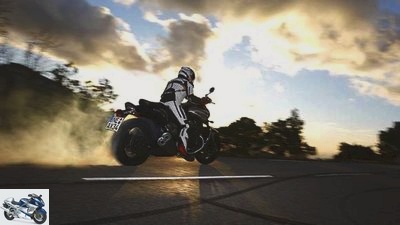
Artist
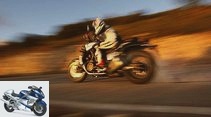
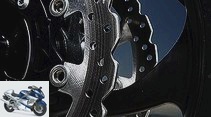
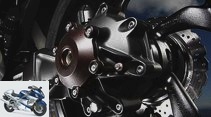

38 photos
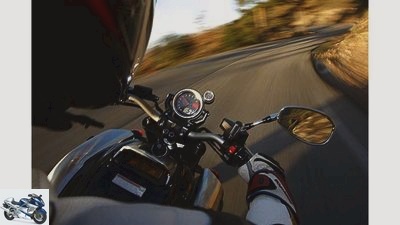
Artist
1/38
…and has to be careful that he does not get sick with constant changes of lean angle.
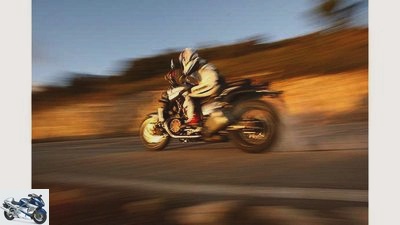
Artist
2/38
The machine comes across. By the way: The Bridgestone BT028 used defied all hardships. Even after the brutal acceleration scenarios for the photo, the test drives and around 1000 hard test kilometers, the rear tire was still in such good shape that the replacement tire did not need to be fitted. The machine was handed over to the sister magazine PS, which carried out its stunt and test drives with the same tire. And he still has a profile…
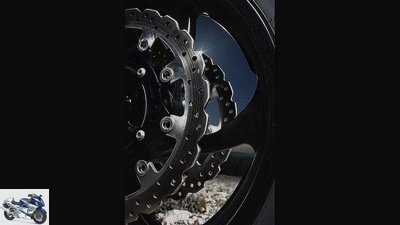
Artist
3/38
…or the gigantic 320 brake discs in wave design. No matter where the eye goes, one involuntarily gets stuck. Here artists let off steam. And apparently made specifications for the technicians. Because even if you go very close…

Artist
4/38
…or the cardan drive, which incidentally hardly causes any disruptive reactions when driving. Anyone who has looked at the photos up to this point may wonder how and under what circumstances these very cool-looking photos were taken. So a little digression at this point: Unfortunately, you cannot see the temperature on the recordings…
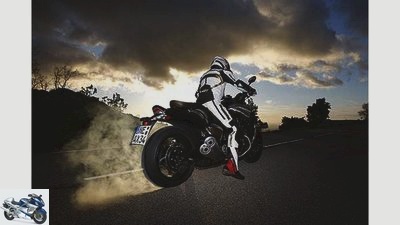
Artist
5/38
The measurement runs, which determined a record acceleration of just 2.7 seconds, only take place on the closed route on the day after this photo production. However, the brute acceleration of the Vmax was staged on site.
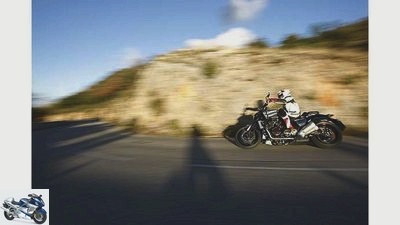
Artist
6/38
Here is a shot in which the photographer’s shadow has to be retouched from the image later. Depending on the game with shutter speed and focus area, the driver has to drive through the same curve up to 25 times until the photo is correct…

Artist
7/38
That means extreme concentration, because the hot, spinning tire slides over the asphalt as if it were soaped with soap…
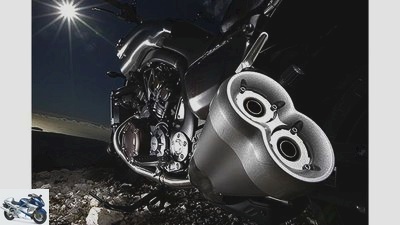
Artist
8/38
The technicians also agreed on the subject of sound: robust, crisp, deep ?? Far more impressive ex works than many a Harley. The machine has two rear silencers made of titanium..
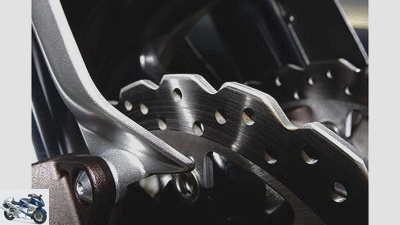
Artist
9/38
…shows the loving fusion of design and technology, which documents what is currently feasible almost everywhere…

Artist
10/38
…while the photographer is constantly changing perspective,…

Artist
11/38
Some driving shots, which should also be made using flash technology (see tripod on the right), turned out to be problematic. Due to the relatively short shutter speed when flashing in connection with the low speed, it looks in the photos as if the wheels are stationary and not turning.
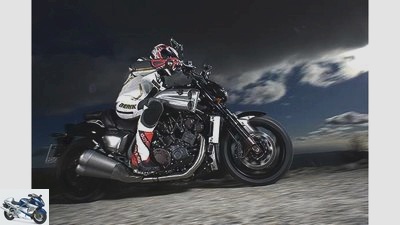
Artist
12/38
The turning of the wheels is then generated on the computer. And then it looks like this….
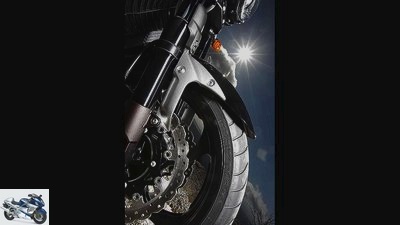
Artist
13/38
…the attachment for the front fender…
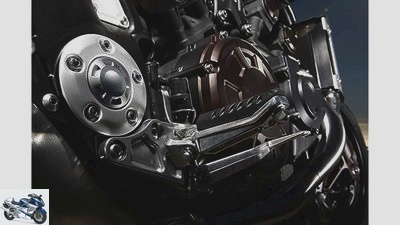
Artist
14/38
Even from the ant’s perspective there are wonderful views. Be it just the footrest, or the cover for the swing arm bearing, the magnesium cover for the clutch…
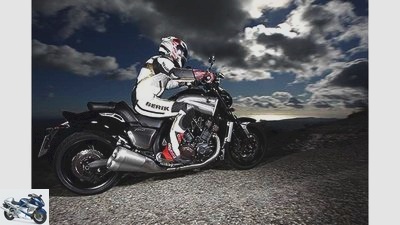
Artist
15/38
…Unfortunately, the whole thing has little to do with dynamics. The decision in favor of some flashed photos was made only because they would go well with the details due to their surreal appearance. The photographer and editor then changed locations for the action photos.
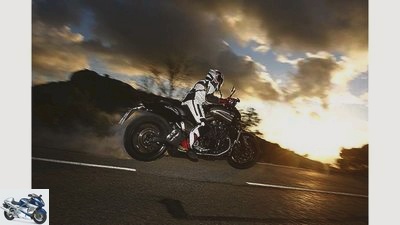
Artist
16/38
In sprint mode, the mighty 200 tire of the machine slips into third gear…
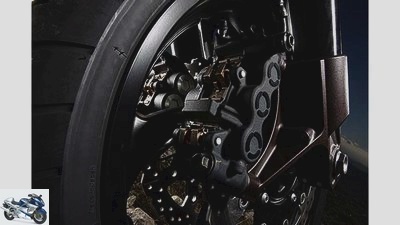
Artist
17/38
…The radially screwed monoblock six-piston fixed calipers are not only the technical and visual icing on the cake, no, they are also ABS-supported. Also the…
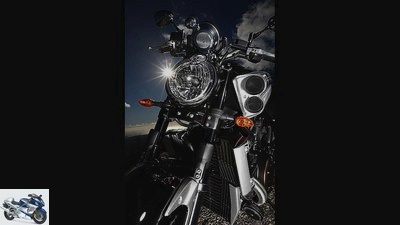
Artist
18/38
…which lead just as huge 52 standpipes. These are coated with titanium oxide, which should make the surface particularly slippery and resistant. Not only does it look good, it also gives the impression that this machine is built to last…
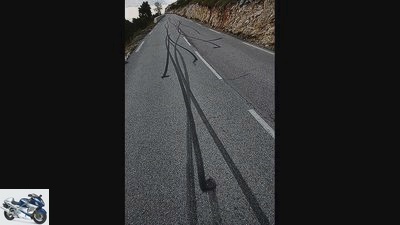
Artist
19/38
I’ll be gone: Test of the Yamaha Vmax 2009 by Rolf Henniges (text) and Jorg Kunstle (photos).
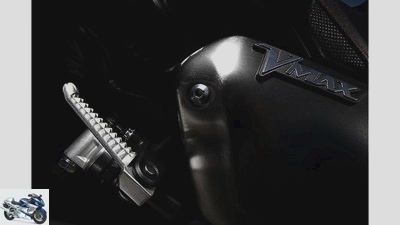
Artist
20/38
A reservoir for the strut installed horizontally is attached behind the right and left passenger footrests. On the right, the compression stage can be adjusted using a handwheel, on the left, the rebound stage is also varied using a handwheel.
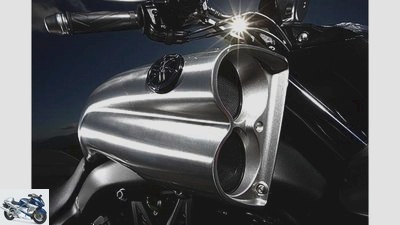
Artist
21/38
In contrast to the old Vmax, in which the intake manifold was only a dummy, the 2009 model breathes greedily through the two extremely eye-catching, hand-polished aluminum snorkels…

Artist
22/38
…Because the sun was shining on December 5th, but the wind on the mountain range was unusually sharp and icy at what felt like minus ten degrees. Unfortunately, photographer Jorg Kunstle had forgotten his hat that day and looked like the famous Rumpelstiltskin when it was jumping around the fire with the rolled-up balaclava from editor Rolf Henniges.
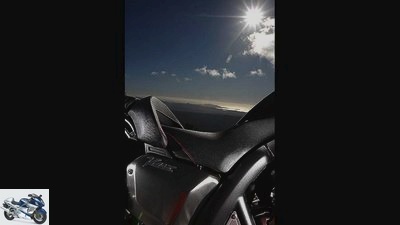
Artist
23/38
…while the bench has been given a small backrest in addition to red decorative stitching…

Artist
24/38
The nuclear power plant: A V4 engine that delivers 192 HP at 8900 rpm and 171 Newton meters at 7600 rpm on the MOTORRAD test bench? that’s a bit insane. Mainly because Yamaha dispenses with traction control and the Vmax puts a fat 110 Newton meters on the rear wheel from idle. By the way: minus the power loss, exactly 181 hp arrive at the rear wheel…
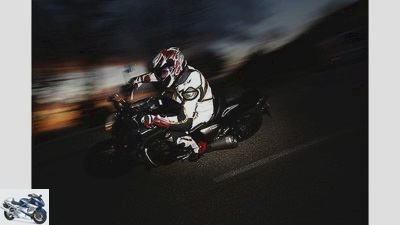
Artist
25/38
It’s one of those days when you get torn as a test editor. On the one hand, there is this motorcycle milestone. A bike that suddenly shifts all impressions. Example: If you step out of the saddle of the Vmax into the Harley-Davidson V-Rod Muscle, which is carried for test purposes, and accelerate, you will not get rid of the feeling of riding a 34-hp bike. By the way: The Muscle also has over 120 hp and a “Porsche engine”. The dark side of such a day is the icy cold despite the warm light, cleaning the morning shift with the machine and the legendary? French breakfast ?. Consists of inedible coffee, a piece of white foam garnished with a sweet spread and watery orange nectar. And at the end of the day a photographer who, thank God, remembers that he has enough flashes with him when the daylight is fading…

Artist
26/38
…which are mounted symmetrically slightly raised on both sides.
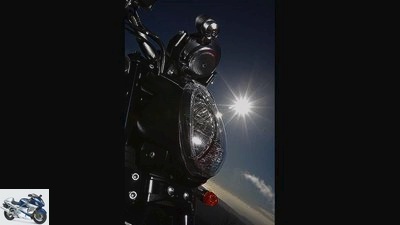
Artist
27/38
…and culminates in such banal details as the cockpit bracket…
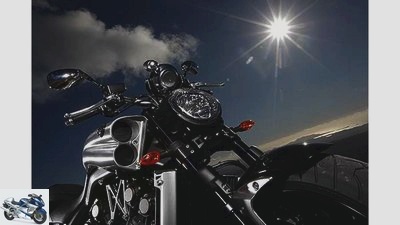
Artist
28/38
…and they were lucky: the sky was bright blue on this Saturday in December, scattered wisps of cloud gave the production a particularly dramatic note….
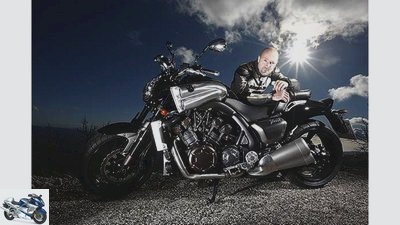
Artist
29/38
Well, the fire in this case was the Vmax. Henniges waited next to the machine for six hours in a perforated leather dress. The fact that he got a little warm was due to the equipment, which had to be rebuilt several times for this production: In order to put the details in a futuristic scene, a complete flash system was set up on the untravelled road: three flash heads, several tripods, a dozen heavier Sandbags to weigh down, a cubic meter of tangled cables and an emergency power generator with 2000 watts of power. A huge awning also helped to put the Vmax in the right light.
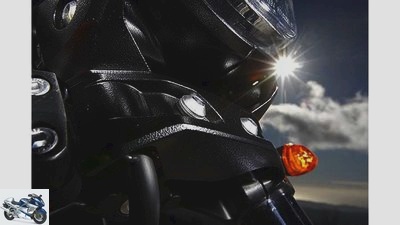
Artist
30/38
…this impression continues on the extremely opulent lamp holder…
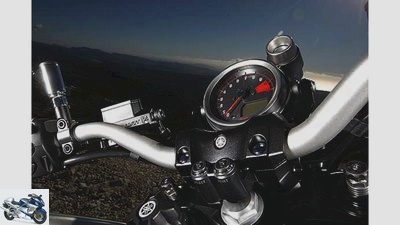
Artist
31/38
…while at the end of the horizon the Mediterranean glittered and put an absolutely surreal stamp on the production. In focus: the handlebars and the cockpit with its huge shift light. When accelerating in sprint mode (the engine management recognizes a sprint from a standstill, more on that later) it flashes every second. This acceleration is just as monumental as the massive handlebar clamp…

Artist
32/38
… sometimes also sits on the back,…
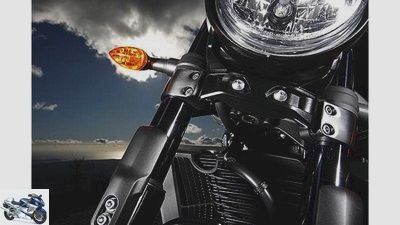
Artist
33/38
…or the massive fork bridges made of die-cast and forged aluminum,…

Artist
34/38
So this is how it looks, the 200 hp monster Yamaha Vmax, a milestone in series motorcycle construction. With just 2.7 seconds from zero to 100 km / h, this Yamaha is the bike with the best acceleration ever recorded by MOTORRAD. Without knowing this value beforehand, this visually brute drag bike should be particularly staged for the photo production. Test editor Rolf Henniges and photographer Jorg Kunstle chose a remote pass in southern France as the location for the photo shoot …
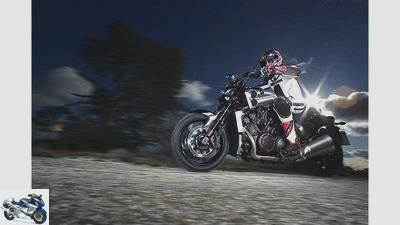
Artist
35/38
…then makes the photographer happy, yes…
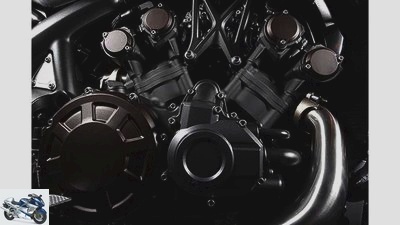
Artist
36/38
…a value that many other bikes can dream of. But let’s go into more detail: The engine management is programmed in such a way that the best possible sprints over the legendary quarter mile are possible? so it says in the Yamaha press release. To put it succinctly: If you accelerate fully from a standstill (regardless of whether from the traffic lights or the starting lights on the drag strip), the engine also turns off in fifth gear. The final speed of the sprint is then just under 260 km / h. The desire to sprint is recognized by comparing the wheel speed (standstill) and the sudden opening of the throttle valve. As soon as you close the throttle valve a little over the period X (around one or two seconds), the sprint mode is deactivated again and the machine goes into driving mode. Then the top speed is locked in fifth gear at 220 km / h.
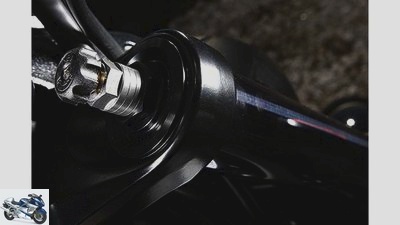
Artist
37/38
…Fork is fully adjustable: While you still need a 17 mm open-ended wrench to change the spring preload, the rebound stage is adjusted using a small hand wheel at the top end of the fork.
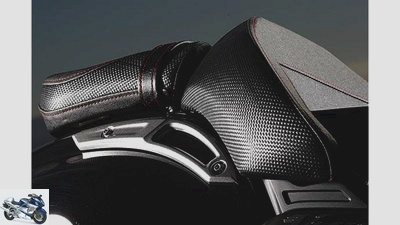
Artist
38/38
…so that the driver can support himself a little when accelerating hard. This backrest must be folded up for refueling. The 15 liter tank is hidden underneath.
Test Yamaha Vmax
200 hp monster bike
Earth, fire, water, air ?? four elements without which we cannot exist. Now a fifth has been added: Anyone who has only used the new Vmax for half a day can hardly imagine living without it.
Dawn in the south of France. Black becomes blue and then orange. It is a Sunday in December 2008. Optical temperature: 20 degrees, feels like minus ten. The new one has hoarfrost Vmax covered with a silver coat. It melts into pearls of glitter, as if in slow motion the sun reveals the 200 hp most powerful production motorcycle in the world – apart from a practically hand-crafted Boss Hoss. In an hour or two, the roads will be dry and test drives can begin. Time enough to sneak around the colossus with a hot coffee, to enjoy the sight of it and to pause for thought. Dawn in the south of France. Black becomes blue and then orange. It is a Sunday in December 2008. Optical temperature: 20 degrees, feels like minus ten. Hoar frost has covered the new Vmax with a silver coat. It melts into pearls of glitter, as if in slow motion the sun reveals the 200 hp most powerful production motorcycle in the world – apart from a practically hand-crafted Boss Hoss. In an hour or two, the roads will be dry and test drives can begin. Time enough to sneak around the colossus with a hot coffee, to enjoy the sight and to pause for thought.
It is undoubtedly a colossus, the editorial scales indicated 314 kilograms. But a delicious colossus. The finest materials, superb workmanship, monumental design. Of the proclaimed 200 hp, “only” 192 remained on the MOTORRAD test bench. And the cardan shaft only sends them to the mighty 200 mm tire in fourth gear. In the third, the machine turns around 1000 revolutions higher, up to just over 10,000 rpm, but with 187 hp, the power is five hp below the maximum power output. In the fifth, the irrepressible vigor of the 1680 cubic V4 is slowed down during normal driving at around 8000 tours by closing throttle valves – at 220 km / h it is over. This is how the Yamaha technicians determined it. Nowadays it is not uncommon to prepare the performance of two-wheeled horsepower limbs in a user-friendly way.
Heavy sprint wonder?
In view of these values, disrespect crept into colleagues: the Vmax a sprint miracle? Under 3.0 seconds to 100 km / h? Will never make it. Never! Why? You just have to calculate: 314 kilograms and a measured 192 hp – each hp has to accelerate 1.64 kg. Need a comparison? Please: The best acceleration ever documented by MOTORRAD with 2.9 seconds from zero to 100 km / h was recently achieved by the new BMW K 1300 R and Kawasaki’s flagship ZZR 1400. A super sports car like the 180 hp and 200 kg light Honda Fireblade requires for the sprint from standing 3.3 seconds to the 100 km / h limit. Because the Blade, like all of its lightning-fast colleagues, fights with a rising front wheel. Even a nearly 400 hp turbo Hayabusa didn’t break the three-second mark. Her permanently spinning rear wheel could not convert the power into thrust. "Then why in the world should this “cruiser” achieve a top score??" asked a colleague.
Why? In addition to a long wheelbase with a balanced wheel load distribution of 50 to 50, the technicians gave the Vmax an extra gimmick: If you accelerate fully from a standstill, the V4 supposedly recognizes that it is now based on a comparison of abrupt throttle opening and wheel standstill about the sausage. He goes into sprint mode and gives everything. Nice. But what is it all? One can be curious. Point ten will be "Cruiser" frightened out of his cold rigidity at the push of a button. Soprano grumbling. Opinions can be divided about the term cruiser. However, if you take key data such as weight, the mighty 1700 millimeters wheelbase, the very flat steering head with 59 degrees and the exorbitant caster of 148 millimeters as a basis, the allocation is not so wrong. Take a seat. Lift the machine from the stand – uff, you can feel every kilo. Turn the handlebars while standing – unbelievable how heavy it feels. Pull the clutch – in gear. Not a bang. No hacking. The gear wheels mesh softly. The hydraulically operated clutch works precisely, runs relatively smoothly, can be adjusted wonderfully and gives away the feeling that it is almost indestructible. A central point in the acceleration measurement. A fat 110 Newton meters are available from idle. They spit the chunk across the street in an unexpectedly vehement and relaxed manner. Because: The cumbersome turning while standing – gone. The feeling of fat six hundredweight – almost reduced to a handy four. Big surprise.
Chassis and brakes
Artist
Quote from a test driver: "When you step on, you think: Oh dear, a cruiser – that can’t drive well. And when you step down again, you think seriously about how you could scrape together the twenty grand."
The handlebars lie comfortably in the hand, are not too wide or too narrow, you have to bend your upper body slightly to grab it. Central in the driver’s field of vision: the huge rev counter with its flange-mounted shift light. In contrast, the info panel is barely legible and is hidden on the dummy tank. It is positioned far too close to the driver’s body. Otherwise, the ergonomics are excellent for smaller drivers. Big ones, however, hit the mighty air scoops with their knees. The feet rest on notches that are quite high. Since these are attached behind the driver, he can better support himself. The bench also has a backrest. In case it really gets down to business … But it can’t for the time being. The fuel gauge reports low tide. Go to the first spigot. Aha, closed on Sundays. Card payment doesn’t work either. Second tank, same problem. That’s it: test drive canceled due to lack of fuel. How do you explain that to the boss? The sun is shining, the streets around the Le Castellet race track are now teeming with bikers. Most popular outfit mix: kevlar boots, bruised black leather jacket and jeans. A ZX-10R driver stops, looks at the Max. He nods approvingly. Of course there would have been a gas station open ten kilometers away. Please follow. He pulls on the cable so extremely, as if there was one euro for every tenth won.
The Vmax accelerates with fascinating ease. Whoever opens the mighty 48 throttle valve self-confidently but respectfully, experiences a thrust that completely erases the memory of the actual weight from the memory. From 6000 rpm all hell breaks in. Then a servo motor reduces the length of the intake funnel, which improves the filling of the cylinders. The system called YCC-I is also used in the YZF-R1 and the R6, it is supposed to increase the power output at high speeds. Obviously it works at Vmax. You stick the super sports car loosely on the straight in the rearview mirror. Feel this mighty V4 beneath you, listen to its wonderful rumble, be happy about such immense reserves of power and suspect: Man, there is much more possible. Corner entrance. Brakes! – Another wonderful feeling. The radially screwed six-piston calipers not only look very high quality, but also decelerate properly. The pressure point of the front brake is clear and it is easy to operate. Two fingers are enough. During the brake measurement, the machine comes to a standstill from 100 km / h after 45.5 meters – that is an average deceleration of 8.5 m / s and unfortunately only mediocre. Perhaps there would be a little more, but the roughly regulating ABS prevents better values.
It is enough to stay tuned to the ZX-10R, because the driver is not chasing records. A long curve is approaching. The giant leans gently. Deep, deeper – you can’t get rid of the feeling, something is about to have to be scraped, a canal in the tar, and a flight of sparks. But the high-mounted footrests allow proper inclines. The casual turning and bending behavior of the Brockens is also surprising. Once on an incline, the fat Max remains stable – on level asphalt. If it gets wavy, it begins to swing slightly. The swanky 200 slipper directs unrest into the chassis. Flawlessly coordinated, the gigantic 52 fork with its 120 millimeter suspension travel filters out almost everything and is also great. At the back it looks different: the shock absorber with its 110 millimeter travel is fully adjustable, as is the fork, but there are short, hard hits unfiltered. Anyway, the gas station is in sight. The French gives his thumbs up and nods in appreciation. He is gone.
"Power out of the sleeve"
Yamaha
Yamaha should give Vmax buyers a folding chair. Hardly any other machine seduces you to sit down and admire as well as driving.
A pull on the hidden lever pops up the seat, which gives access to the tank. It holds 15 liters. Let’s see how far you can get with it. The horsepower monster masters the country road swing skillfully. And belies anyone who uses the expression "Shake power casually out of your sleeve" has ever used before. Regardless of when the shower is opened, things are making great progress. From 3000 rpm, the Vmax hovers on a torque plateau of 135 Newton meters. From 4000 rpm the V4 clenches its fists and 2300 tours later lifts a trembling 171 Newton meters. But the sheer performance is not impressive. Rather, it’s the way the Vmax feels: confident in every respect. It never appears nervous or fidgety, nor does it tempt you to heat. It is the trump card up its sleeve. This motorcycle is the perfect symbiosis between cruiser, sport and muscle bike. And it’s so easy to ride that even cold, damp mountain passes don’t bring sweat to your forehead.
170 kilometers of country road lie behind the 18-inch wheels of the Vmax. On average, the engine consumed an impressive seven liters per 100 kilometers. Now it goes on a closed route to determine the acceleration values. It is 2 p.m., twelve degrees Celsius and almost no wind. Test driver Georg Jelicic is at the start, engages and starts shooting. It looks like the Vmax is being shot out of an oversized twin. 1680 cubic roars, it smokes, it stinks. What remains is a 200-meter-long black line – the rear wheel spins through to third gear. Still: 2.9 seconds from zero to 100. Second attempt: 2.8 seconds. “You have to engage the clutch earlier than you thought, not to tear open the gas quite as violently, then there’s more to it,” says Georg and makes it come true: 2.7 seconds. It stays that way. Absolute record.
By the way, it says in Yamaha’s press prose: “Although the top speed is limited to 220 km / h, an intelligent system enables full power when accelerating over a quarter mile.” Very mysterious. Whatever it is, you have never seen such acceleration on a production motorcycle. This sprint mode is eerily beautiful and literally screams for permanent repetition. It has absolutely nothing in common with normal driving. Yamaha has set a milestone with the new Vmax. The 19,750 euro machine looks more elegant and is even more confident and casual than many a Harley. And by the way, it is even suitable for everyday use and accelerates faster than anything that is currently approved. The Vmax has only one flaw: it is addicting. What’s wrong with that? In 2009 only 1500 copies will be delivered to Europe. Order exclusively over the Internet. Test drives impossible.
The center of power
Yamaha
The fifth element: Yamaha Vmax.
With a nominal 200 hp, the Vmax sets a milestone in series motorcycle construction. What was hardly imaginable ten years ago: Thanks to the latest electronics and fuel injection, the performance is wonderfully realizable. Compared to the original Vmax, the displacement grew thanks to a bore that was enlarged from 76 to 90 millimeters. The stroke of 66 millimeters remained, the compression was increased from 10.5 to 11.3 to one. Despite a 40 percent increase in displacement, the new V4 is only 27 millimeters shorter than its predecessor, is roughly the same width and is only 6.5 millimeters higher. This was made possible by a reduced cylinder angle, very compact cylinder heads with roof-shaped combustion chambers and steeply positioned valves: 14 degrees on the exhaust side, 15 degrees on the inlet side ?? the total angle has shrunk to 29 degrees compared to the original Vmax (36 degrees). So much for the key data.
In contrast to the massive air scoops of its predecessor, which were pure mock-ups, the new V4 breathes air into an airbox that is about twice as large through its hand-polished aluminum snorkel. All the high-tech features currently used in series production come together inside the V4: intake pipes with variable lengths, anti-hopping clutch, electronically controlled throttle valves or Exup roller in the exhaust. The clutch and generator covers as well as the transmission tunnel are made of magnesium. Four liters of coolant circulate through two radiators to cool the power plant. The 4.7 liters of engine oil are also chased through a cooler? the Brocken is thermally resilient. Acceleration scenarios performed several times in a row put away not only the clutch, but also the cooling system.
The real wonder of this engine is its ability to adapt. Regardless of whether it is predictable power input for swinging on the country road or brute force development for the sprint over the quarter mile: a computer determines all operating conditions a thousand times per second, such as wheel speed, injection quantity or throttle valve position, and ensures that the engine does not choke if the throttle cable closes is excited, nor that he is too aggressive when cruising. The enormous 171 Newton meters can be used for gliding in the same way as they paint fat lines on the road.
Technical data Yamaha Vmax
engine
Water-cooled four-cylinder, four-stroke, 65-degree V engine, two overhead, gear / chain-driven camshafts, four valves per cylinder, bucket tappets, wet sump lubrication, injection, regulated catalytic converter, 420 W alternator, 12 V / 11 Ah battery, hydraulic actuated multi-plate oil bath clutch, (anti-hopping), five-speed gearbox, cardan, secondary ratio 3.082.
Bore x stroke 90.0 x 66.0 mm
Cubic capacity 1680 cm³
Compression ratio 11.3: 1
Rated output 147.2 kW (200 hp) at 9000 rpm
Max. Torque 167 Nm at 6500 rpm
landing gear
Bridge frame made of aluminum, telescopic fork, Ø 52 mm, adjustable spring base, rebound and compression damping, two-arm swing arm made of aluminum, central spring strut with lever system, adjustable spring base, rebound and compression damping, double disc brake at the front, Ø 320 mm, six-piston fixed caliper, disc brake at the rear, Ø 298 mm, single-piston floating caliper, ABS.
Cast aluminum wheels 3.50 x 18; 6.0 x 18
Tires 120/70 R 18; 200/50 R 18
Tires in the test Bridgestone BT 028 ?? G ??
Dimensions + weights
Wheelbase 1700 mm, steering head angle 59.0 degrees, caster 148 mm, spring travel f / r 120/110 mm, seat height * 780 mm, weight with a full tank * 314 kg, payload * 186 kg, tank capacity 15.0 liters.
Two year guarantee
Service intervals every 10000 km
Color: Black
Price 19750 euros
Additional costs around 205 euros
Readings
Performance
Top speed 220 km / h
acceleration
0 100 km / h 2.7 sec
0 ?? 140 km / h 4.4 sec
0 200 km / h 8.3 sec
Draft
60 ?? 100 km / h 3.1 sec
100 ?? 140 km / h 3.3 sec
140 180 km / h 3.2 sec
Speedometer deviation
Effective (display 50/100) 47/93 km / h
consumption
Country road 7.1 l / 100 km
Theor. Range of the country road 211 km
Fuel type super
Related articles
-
Yamaha 15th photos Yamaha 1/15 … in which the V4 is screwed in four places and has a load-bearing function. Yamaha 2/15 Yamaha’s new Vmax is a beast….
-
Endurance test interim balance of the Yamaha XT 1200 Z Super Tenere
Photo: j.kuenstle.de 20 images 1/20 The Yamaha XT 1200 Z Super Tenere doesn’t care about the goals: whether for camping in the Allgau, in a hotel in northern Germany or for …
-
BMW, Yamaha and Kawasaki Powerbikes in the test
fact 17 pictures fact 1/17 Completely different concepts – with one thing in common: Apparently unlimited power. BMW S 1000 RR, Yamaha Vmax and Kawasaki …
-
Comparison test Suzuki B-King, Yamaha MT-01 and Triumph Rocket III
fact 15 pictures artist 1/15 artist 2/15 artist 3/15 artist 4/15 artist 5/15 artist 6/15 artist 7/15 artist 8/15 artist 9/15 artist 10/15 artist …
-
fact 30 pictures fact / Joachim Schahl 1/30 There is movement in the middle class. The Yamaha MT-09 is ready with a well-presented three-cylinder, which …
-
Comparison test: Ducati Diavel, Suzuki B-King and Yamaha Vmax
Jahn comparison test: Power Bikes 2011 Ducati Diavel, Suzuki B-King and Yamaha Vmax Content from Big appearance, powerful sound waves, pressure from all …
-
BMW F 800 R, Kawasaki Z 800, MV Agusta Brutale 800 and Yamaha FZ8 in the test
Jahn 29 pictures Jahn 1/29 A comparison of four 800 class motorcycles: BMW F 800 R, Kawasaki Z 800, MV Agusta Brutale 800 and Yamaha FZ8. Jahn 2/29 How …
-
Suzuki Hayabusa, Kawasaki Ninja H2, Aprilia RSV4 RF and Yamaha Vmax in the test
Bilski 41 photos Bilski 1/41 Yamaha Vmax, Suzuki Hayabusa, Aprilia RSV4 RF, Kawasaki Ninja H2. Each of these four machines has its own special charm….
-
Jorg Kunstle Top-Test Yamaha FZ1 / Fazer Are you going now? We had to wait a long time for that: a naked Nippon athlete. Not washed soft, but …
-
Harley-Davidson Sportster 883 Iron and Yamaha XV 950 in the test
Gargolov 34 photos Gargolov 1/34 Both cruisers aim high. Which bike is more convincing?? Gargolov 2/34 The point for the feel-good effect clearly goes to…